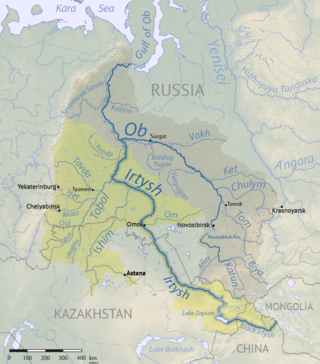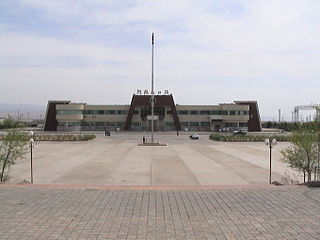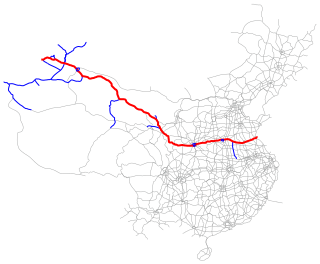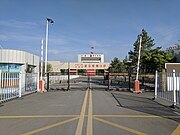
The Irtysh is a river in Russia, China, and Kazakhstan. It is the chief tributary of the Ob and is also the longest tributary river in the world.

Ili Kazakh Autonomous Prefecture is an autonomous prefecture in northern Xinjiang, China. Its capital is Yining, also known as Ghulja or Kulja.

The Eurasian Land Bridge, sometimes called the New Silk Road, is the rail transport route for moving freight and passengers overland between Pacific seaports in the Russian Far East and China and seaports in Europe. The route, a transcontinental railroad and rail land bridge, comprises the Trans-Siberian Railway, which runs through Russia and is sometimes called the Northern East-West Corridor, and the New Eurasian Land Bridge or Second Eurasian Continental Bridge, running through China and Kazakhstan. As of November 2007, about one percent of the $600 billion in goods shipped from Asia to Europe each year were delivered by inland transport routes.

Yining, also known as Ghulja or Kulja, is a county-level city in Northwestern Xinjiang, China and the seat of Ili Kazakh Autonomous Prefecture. Historically, Yining is the successor to the ruined city of Almaliq in neighbouring Huocheng County. Yining is the third largest city in Xinjiang after Ürümqi and Korla.

Ehmetjan Qasim was a Uyghur revolutionary and statesman who held several important positions in the governments of the Second East Turkestan Republic and the Republic of China's Xinjiang Province. He notably served as the vice chairman of the Coalition Government of Xinjiang Province.

Tacheng, also known as Tarbagatay, Chuguchak or Qoqek, is a county-level city and the administrative seat of Tacheng Prefecture, in northern Ili Kazakh Autonomous Prefecture, Xinjiang. The Chinese name "Tacheng" is an abbreviation of "Tarbagatay City", a reference to the Tarbagatay Mountains. Tacheng is located in the Dzungarian Basin, some 10 km (6.2 mi) from the Chinese border with Kazakhstan. For a long time it has been a major center for trade with Central Asia because it is an agricultural hub. Its industries include food processing, textiles, and utilities.

Bortala Mongol Autonomous Prefecture is an autonomous prefecture in the northern Xinjiang, China. Its capital is Bole, also known as Bortala. It has a population of 475,483 inhabiting an area of 27,000 km2 (10,000 sq mi). Despite being designated an autonomous area for Mongols in China, only a little over five and a half per cent of Bortala's population is Mongol.

Qapqal Xibe Autonomous County in Ili Kazakh Autonomous Prefecture in Northern Xinjiang, is the only Xibe autonomous county of China, bordering Kazakhstan's Almaty Region to the west. It has an area of 4,430 square kilometers and a population 160,000 (2000). Qapqal means "the granary" in the Xibe language.

Alashankou is a border city in Bortala Mongol Autonomous Prefecture, Xinjiang Uyghur Autonomous Region, China. It is a port of entry by both railroad and highway from Kazakhstan as part of the Eurasian Land Bridge.

Alashankou railway station, also known as Alataw Pass railway station, is a railway station in Börtala Mongol Autonomous Prefecture of China's Xinjiang Uyghur Autonomous Region.

Zhaosu County, also known as Mongolküre County, is a county in northwestern Xinjiang, China. It is under the administration of Ili Kazakh Autonomous Prefecture and shares a border with Kazakhstan's Almaty Region to the west. It covers an area of 10,455 km2 (4,037 sq mi). According to the 2012 census, it had a population of 189,102.

Huocheng County, as the official romanized name, is also transliterated from Uyghur as Korgas County. It is situated within the Xinjiang Uyghur Autonomous Region and falls under the administration of the Ili Kazakh Autonomous Prefecture. The county is located between Yining and the border city of Khorgas, covering an area of 5,466 km2 (2,110 sq mi), with a population of 360,000. There are twenty-nine ethnic groups residing in the county, including the Han and Uyghur nationalities.

China–Kazakhstan relations refer to the relations between historical China and the Kazakhs up to the modern relations between the PRC and Kazakhstan. Ever since the establishment of diplomatic relations in 1992, political, cultural, and economic ties have developed between the two. The Chinese Communist Party and Kazakhstan's Amanat have good ties. China has said that it values exchanges between the two parties and hopes to strengthen ties and cooperation even further.

The Northern Xinjiang railway or Beijiang railway is a railway in Xinjiang, China, between Ürümqi, the regional capital of Xinjiang, and Alashankou on the border with Kazakhstan. The railway is 460 km (290 mi) in length and runs along the northern slope of the Tian Shan mountain range, connecting all major cities and towns of the southern Junggar Basin, including Changji, Hutubi, Manas, Shihezi, Kuytun, Wusu, Bortala (Bole), Jinghe and Alashankou. The line extends the Lanzhou–Xinjiang railway west from Ürümqi to the Turkestan–Siberia railway on the Kazakh border and forms a section of the Trans-Eurasian Railway from Rotterdam to Lianyungang. The line opened in 1992. It was partially funded by the government loan of the Soviet Union.

The Jingyihuo railway, short for Jinghe–Yining–Khorgas railway, is the first electrified railway in operation in Xinjiang, China. The line is 286 km in length and connects Jinghe, Yining and Khorgos. The Jingyihuo railway branches from the Northern Xinjiang railway at Jinghe in the Junggar Basin and heads south through the Tian Shan range into the Ili River Valley. Cities and towns along route include Jinghe, Nilka County, Yining County, Yining, Huocheng County and Khorgos, on the border with Kazakhstan.

The Lianyungang–Khorgas Expressway, designated as G30 and commonly referred to as the Lianhuo Expressway, is 4,243-kilometre-long expressway (2,636 mi) in China that connects the cities of Lianyungang, in the province of Jiangsu, and Khorgas, in the autonomous region of Xinjiang, on the border with Kazakhstan. At Khorgas, there is a border crossing into Kazakhstan. The expressway is the longest contiguous expressway in China with a single numeric designation, stretching across the country from the Yellow Sea on the east coast to the Kazakhstan border in the west. It passes through the provinces of Jiangsu, Anhui, Henan, Shaanxi, Gansu, and Xinjiang.

The China–Kazakhstan border, also known as the Sino-Kazakh border, is the international border between the People's Republic of China and the Republic of Kazakhstan.
Ejin–Hami railway or Eha railway, is a railway in western China between Ejin Banner in Alxa League of western Inner Mongolia and the city of Hami in the eastern part of the Xinjiang Uyghur Autonomous Region. The line runs 644 km (400 mi) through the deserts near the Mongolian border. Apart from Inner Mongolia and Xinjiang, the line also crosses the Subei Mongol Autonomous County, the sliver of Gansu Province that extends to the Mongolian border. Construction began on June 30, 2014 and was slated to take three years, but the line opened only 17 months later on December 1, 2015. The opening of this rail line shortened the distance by rail from Hohhot, Inner Mongolia's capital, to destinations in Xinjiang and Kazakhstan by over 800 km.
Dıar Qūrmaşūly is a Chinese politician of Kazakh ethnicity who served as vice chairman of the Xinjiang Regional Committee of the Chinese People's Political Consultative Conference from 1988 to 1998, and governor of Ili Kazakh Autonomous Prefecture from 1983 to 1988.
From September 14 to 16, 2022, Chinese President Xi Jinping attends the 22nd meeting of the Council of Heads of State of the Shanghai Cooperation Organization (SCO) member states in Samarkand, and pay state visits to Kazakhstan and Uzbekistan at the invitation of the Kazakh President Kassym-Jomart Tokayev and Uzbek President Shavkat Mirziyoyev.
























